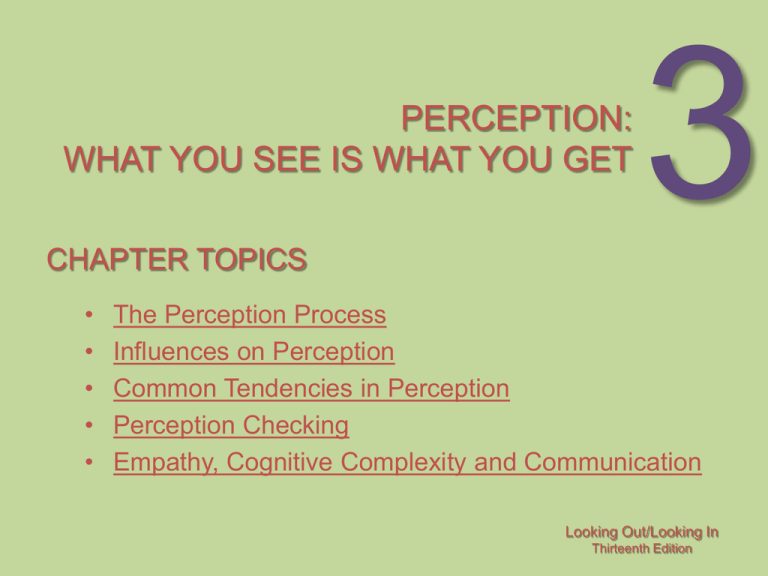
PERCEPTION:
WHAT YOU SEE IS WHAT YOU GET
3
CHAPTER TOPICS
•
•
•
•
•
The Perception Process
Influences on Perception
Common Tendencies in Perception
Perception Checking
Empathy, Cognitive Complexity and Communication
Looking Out/Looking In
Thirteenth Edition
The Perception Process
• Four Steps of the Perception Process
• Selection
• Organization
• Interpretation
• Negotiation
PERCEPTION: WHAT YOU SEE IS WHAT YOU GET
2
The Perception Process
• Selection
• What attracts your attention?
• Selecting which impressions we will attend to
• Stimuli that are intense often attract our attention
• We’re more likely to remember:
• Extremely tall or short people
• An obnoxious laugh
• A person who speaks loudly
PERCEPTION: WHAT YOU SEE IS WHAT YOU GET
3
The Perception Process
• Organization
• Along with selecting information, we must
arrange it in some meaningful way
• What do you see?
• Which image stands out?
Figure 3.1 Page 84
PERCEPTION: WHAT YOU SEE IS WHAT YOU GET
4
The Perception Process
• Organization
• “Vase-Face” has a two figure relationships
• How many ways can you view the boxes?
PERCEPTION: WHAT YOU SEE IS WHAT YOU GET
Figure 3.3 Page 85
5
The Perception Process
• Organization
• We classify people based on their:
• Appearance
• Beautiful or Ugly, Young or Old
• Social Role
• Student, Attorney, Wife
• Interaction Style
• Friendly, Helpful, Aloof
• Membership
• Democrat, Immigrant, Christian
PERCEPTION: WHAT YOU SEE IS WHAT YOU GET
6
The Perception Process
• Organization
• Stereotyping
• After the organizational scheme has been chosen,
we use that scheme to make generalizations
• These generalizations lead to stereotyping
• Stereotypes may be based on a small amount of
truth but beyond the facts at hand usually have no
valid basis
PERCEPTION: WHAT YOU SEE IS WHAT YOU GET
7
The Perception Process
• Organization
• Stereotyping
• Three Characteristics
• You often categorize people on the basis of an easily
recognized characteristic
• You ascribe a set of characteristics to most or all
members of a category
• You apply the set of characteristics to any member of the
group
PERCEPTION: WHAT YOU SEE IS WHAT YOU GET
8
The Perception Process
• Organization
• Punctuation
• Consider the punctuation of these sentences:
• “I don’t like your friend because he never has anything to
say.”
• “He doesn’t talk to you because you act like you don’t
like him.”
• “I keep talking because you interrupt so much.”
• “I interrupt so much because you don’t give me the
chance to say what’s on my mind.”
PERCEPTION: WHAT YOU SEE IS WHAT YOU GET
9
The Perception Process
• Interpretation
• After we organize information we interpret it in
a way that makes sense to us
• Interpretation plays a role in nearly every
interpersonal act
• Consider these scenarios:
• Is a friend’s kidding a sign of affection or irritation?
• Should you take an invitation to “drop by any time”
literally or not?
PERCEPTION: WHAT YOU SEE IS WHAT YOU GET
10
The Perception Process
• Interpretation
• Several factors influence our interpretation of
an event:
•
•
•
•
•
•
•
Degree of involvement with the other person
Personal experience
Assumptions about human behavior
Attitudes
Expectations
Knowledge
Self-concept
PERCEPTION: WHAT YOU SEE IS WHAT YOU GET
11
The Perception Process
• Negotiation
• Sense-making occurs between people as they
influence one another’s perception
• Narratives
• Interpersonal acts have more than one narrative
• These narratives often differ
• Ask two quarreling children what they are fighting about
• You will be bombarded with two very different narratives
• Shared narratives provide the best chance for
smooth communication
PERCEPTION: WHAT YOU SEE IS WHAT YOU GET
12
Influences on Perception
• Physiological Influences
• Each of us perceives the work in a unique
way
• The Senses
• How we experience our senses changes the way
we interact and shape our perception
• Consider these everyday situations:
• “Turn down the radio! It’s going to make me go deaf.”
• “It’s not too loud. If I turn it down, it will be impossible to
hear it.”
PERCEPTION: WHAT YOU SEE IS WHAT YOU GET
13
Influences on Perception
• Physiological Influences
• The Senses
• Scents that please some people, repel others
• Temperature is subjective as well
PERCEPTION: WHAT YOU SEE IS WHAT YOU GET
14
Influences on Perception
• Physiological Influences
• Age
• Older people view the world differently because
they have a greater scope of experiences
• Health and Fatigue
• How do you experience the world?
• When you are tired?
• When you are sick?
• Did you feel less sociable?
• When you’re hungry?
PERCEPTION: WHAT YOU SEE IS WHAT YOU GET
15
Influences on Perception
• Cultural Differences
• Perception is also affected by your culture
• Every culture has its own world view
• The range of cultural differences is wide
• In Middle Eastern countries:
• Personal scents play an important role in communication
• In Asian cultures
• Talk is perceived differently
• Silence is valued
• How does this differ for Western cultures?
PERCEPTION: WHAT YOU SEE IS WHAT YOU GET
16
Influences on Perception
• Cultural Differences
• Ethnocentrism
• The attitude that one’s own culture is superior to
others
• Geography
• Even ones physical location can shape the way
they view the world
• Consider living in a particular part of the country
• What does it mean to live in the North?
• What does it mean to live in the West?
PERCEPTION: WHAT YOU SEE IS WHAT YOU GET
17
Influences on Perception
• Social Roles
• Gender Roles (Sex vs. Gender)
• Sex refers to biological characteristics
• Gender refers to psychological dimensions of
masculine and feminine behavior
• Gender roles are socially approved ways that men
and women are expected to behave
• Androgynous Gender Role
• Combines masculine and feminine traits
PERCEPTION: WHAT YOU SEE IS WHAT YOU GET
18
Influence on Perception
• Social Roles
• Occupational Roles
• The kind of work we do influences our view of
the world
• Imagine five people taking a walk through the park
•
•
•
•
•
A botanist
A zoologist
A meteorologist
A psychologist
A pickpocket
PERCEPTION: WHAT YOU SEE IS WHAT YOU GET
19
Influence on Perception
• Social Roles
• Relational roles
• Roles you play in relation to others
• The role of parent
• Does being a parent change the way you view the world?
• The roles involved in romantic love
• Partner, spouse, boyfriend/girlfriend, sweetheart
• Your romantic roles can also change the way you
view others
PERCEPTION: WHAT YOU SEE IS WHAT YOU GET
20
Common Tendencies in
Perception
• We Judge Ourselves More Charitably
• Self-serving Bias
• An attempt to convince ourselves that the positive
face we show the world is true
• Consider this example:
• When they botch a job, they weren’t listening well or
trying hard enough
• When we botch a job, the problem was unclear or
perhaps there wasn’t enough time
PERCEPTION: WHAT YOU SEE IS WHAT YOU GET
21
Common Tendencies in
Perception
• We Cling to First Impressions
• Halo Effect
• The tendency to form an overall positive
impression of a person on the basis of one positive
characteristic
• We assume that others are similar to us
• We are influenced by the obvious
PERCEPTION: WHAT YOU SEE IS WHAT YOU GET
22
Perception Checking
• The Skill of Perception Checking
• Serious problems can arise when we treat our
interpretations as matters of fact
• Consider the following:
• “Why are you mad at me?” (Who said you were?)
• “What’s the matter with you?” (Who said anything
was the matter?)
• “Come on now. Tell the truth.” (Who said you were
lying?)
PERCEPTION: WHAT YOU SEE IS WHAT YOU GET
23
Perception Checking
• Elements of Perception Checking
• A perception check has three parts:
• A description of the behavior you noticed
• At least two possible interpretations of the behavior
• A request for clarification about how to interpret the
behavior
PERCEPTION: WHAT YOU SEE IS WHAT YOU GET
24
Perception Checking
• Example:
• “You haven’t laughed much in the last couple
of days.” (behavior)
• “It makes me wonder whether something’s
bothering you,” (first interpretation)
• “or whether you’re just feeling quiet.” (second
interpretation)
• “What’s up?” (request for clarification)
PERCEPTION: WHAT YOU SEE IS WHAT YOU GET
25
Perception Checking
• Perception Checking Considerations
• Completeness
• A perception check doesn’t always need all parts
• Nonverbal Congruency
• Nonverbal behavior reflects open-mindedness
• Cultural Rules
• A straight forward approach may cause problems
• Face Saving
• Can help raise an uncomfortable topic
PERCEPTION: WHAT YOU SEE IS WHAT YOU GET
26
Empathy, Cognitive Complexity
and Communication
• Empathy
• The ability to re-create another person’s
perspective, to experience the world from the
other’s point of view
• Sympathy
• Viewing another person’s situation from your
point of view
PERCEPTION: WHAT YOU SEE IS WHAT YOU GET
27
Empathy, Cognitive Complexity
and Communication
• Cognitive Complexity
• The ability to construct a variety of
frameworks for viewing an issue
• Cognitive complexity:
• Increases the chances of satisfying communication
in a variety of contexts
• Can be enhanced through training
• Can help increase one’s empathy
PERCEPTION: WHAT YOU SEE IS WHAT YOU GET
28
Empathy, Cognitive Complexity
and Communication
• The Pillow Method
• A quick tool for clarifying misunderstandings
Figure 3.5 Page 110
PERCEPTION: WHAT YOU SEE IS WHAT YOU GET
29
Empathy, Cognitive Complexity
and Communication
• The Pillow Method
•
•
•
•
Position 1: I’m Right, You’re Wrong
Position 2: You’re Right, I’m Wrong
Position 3: Both Right, Both Wrong
Position 4: The Issue Isn’t as Important as it
Seems
• Position 5: There is Truth in All Four
Perspectives
PERCEPTION: WHAT YOU SEE IS WHAT YOU GET
30
Chapter Review
•
•
•
•
•
The Perception Process
Influences on Perception
Common Tendencies in Perception
Perception Checking
Empathy, Cognitive Complexity and
Communication
PERCEPTION: WHAT YOU SEE IS WHAT YOU GET
31









